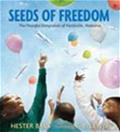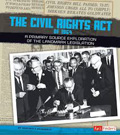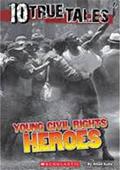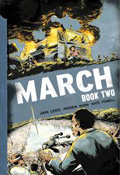There are defining moments in history—wars, economic pitfalls, struggles for a just society. There are few times in U.S. history that stand out more than the Civil Rights Movement. Through (largely) non-violent demonstrations, the side of the just was able to overcome a (largely) violent opposition. Everyday heroes stood up to be counted and after they won, most simply returned to their homes without much fanfare.
In these reviews, we visit both fictional and non-fictional recollections of the Civil Rights Movement and discover that 50 years later, there are still things to learn about this pivotal time.
Ages 4-8
Altman, Linda Jacobs. (2015, paperback). Singing With Momma Lou. Illus. by Larry Johnson. New York: Lee and Low Books.
 Originally published in 2002 and arriving in paperback in the spring, this story begins as 9-year-old Tamika Jones dreads visiting her grandmother in a nursing home. Her aged grandmother, Momma Lou, suffers from Alzheimer’s and most times does not even know who Tamika is. Her father shares the scrapbooks Momma Lou kept as a young girl during the Civil Rights Movement. Tamika decides to use the scrapbooks to have something to share when she visits her grandmother. Momma Lou recognizes a newspaper clipping from demonstration and begins singing a song she remembers celebrating human rights and those days of protest. The author’s mother was a victim of Alzheimer’s so she has written this story from her own experiences.
Originally published in 2002 and arriving in paperback in the spring, this story begins as 9-year-old Tamika Jones dreads visiting her grandmother in a nursing home. Her aged grandmother, Momma Lou, suffers from Alzheimer’s and most times does not even know who Tamika is. Her father shares the scrapbooks Momma Lou kept as a young girl during the Civil Rights Movement. Tamika decides to use the scrapbooks to have something to share when she visits her grandmother. Momma Lou recognizes a newspaper clipping from demonstration and begins singing a song she remembers celebrating human rights and those days of protest. The author’s mother was a victim of Alzheimer’s so she has written this story from her own experiences.
Bass, Hester. (2015) Seeds of Freedom: The Peaceful Integration of Huntsville, Alabama.
Illus. by E.B. Lewis. New York: Candlewick.
 The author, a former resident of Huntsville, relates the story of the peaceful integration of the city and schools in Huntsville, Alabama, when many Southern cities were facing violence and destruction. Written in present tense, the events unfold from July of 1962 to September of 1963. Sit-ins, boycotts, and other forceful protests are described as residents work together to integrate their community. E.B. Lewis’s watercolor illustrations depict the town, streets, and people with revealing heartfelt emotions but also representing civic pride in their community. This informative picture book shows a community creatively coming together without resorting to violence.
The author, a former resident of Huntsville, relates the story of the peaceful integration of the city and schools in Huntsville, Alabama, when many Southern cities were facing violence and destruction. Written in present tense, the events unfold from July of 1962 to September of 1963. Sit-ins, boycotts, and other forceful protests are described as residents work together to integrate their community. E.B. Lewis’s watercolor illustrations depict the town, streets, and people with revealing heartfelt emotions but also representing civic pride in their community. This informative picture book shows a community creatively coming together without resorting to violence.
Meyer, Susan Lynn. (2015). New Shoes. Illus. by Eric Velasquez. New York: Holiday House.
 Young Ella Mae is off to the shoe store to buy her first pair of shoes, no longer having to wear the hand-me-downs of her older brother. However, when she and her mother arrive at Mr. Johnson’s shoe store, Ella Mae experiences her first run-in with discrimination as the white customers get waited on while Ella Mae and her mother look on, ignored. Furious, Ella Mae and her cousin Charlotte, in the true spirit of entrepreneurship and protest, decide to create their own neighborhood shoe store. Doing odd jobs for money and collecting old shoes, they shine, polish, and refurbish shoes the neighborhood shop they open in Ella Mae’s backyard. The author’s note at the end of the book further explains the practices of Jim Crow and goes on to give some history of civil rights and the Voting Rights Act. The publisher has provided an Educator Guide aligned with Common Core Standards.
Young Ella Mae is off to the shoe store to buy her first pair of shoes, no longer having to wear the hand-me-downs of her older brother. However, when she and her mother arrive at Mr. Johnson’s shoe store, Ella Mae experiences her first run-in with discrimination as the white customers get waited on while Ella Mae and her mother look on, ignored. Furious, Ella Mae and her cousin Charlotte, in the true spirit of entrepreneurship and protest, decide to create their own neighborhood shoe store. Doing odd jobs for money and collecting old shoes, they shine, polish, and refurbish shoes the neighborhood shop they open in Ella Mae’s backyard. The author’s note at the end of the book further explains the practices of Jim Crow and goes on to give some history of civil rights and the Voting Rights Act. The publisher has provided an Educator Guide aligned with Common Core Standards.
Ages 9-11
Draper, Sharon M. (2015). Stella by Starlight. New York: Atheneum Books for Young Readers.
 Inspired by her grandmother’s journals, author Sharon M. Draper writes the story of 10-year-old Stella Mills in 1932 Bumblebee, NC. Times are tough as the Depression weighs heavily on the community. Stella finds solace writing in journals, often at the end of the day under the stars. One night she and her brother, Jojo, are outside later than normal and see a Ku Klux Klan rally. There has not been any Klan activity in their area for a long time so Stella is fearful as to what this might mean as her African American community readies to register to vote. Draper has included many exciting and suspenseful events, including snakebites and beatings, but also reveals a community bound together by their shared histories. Folk stories, hymns, diaries, and journals are part of the literature within the story that brings this piece of civil rights history to readers.
Inspired by her grandmother’s journals, author Sharon M. Draper writes the story of 10-year-old Stella Mills in 1932 Bumblebee, NC. Times are tough as the Depression weighs heavily on the community. Stella finds solace writing in journals, often at the end of the day under the stars. One night she and her brother, Jojo, are outside later than normal and see a Ku Klux Klan rally. There has not been any Klan activity in their area for a long time so Stella is fearful as to what this might mean as her African American community readies to register to vote. Draper has included many exciting and suspenseful events, including snakebites and beatings, but also reveals a community bound together by their shared histories. Folk stories, hymns, diaries, and journals are part of the literature within the story that brings this piece of civil rights history to readers.
Schwartz, Heather. (2015). The Freedom Riders: A Primary Source Exploration of the Struggle for Racial Justice. (We Shall Overcome series). Mankato, MN: Capstone Press.
 Through archival photographs, newspaper accounts, quotes from white and African American civil rights workers, politicians, or eyewitnesses, these primary sources make this period of American history become real. The old adage “a picture is worth a 1,000 words” is certainly true as readers examine the statement the selected photographs make. Teachers might like to use the “Question, Observe, Reflect” activity on looking at historic photographs from the Smithsonian or the Photo Analysis worksheet from the National Archives. Examining the quotes and newspaper articles from the Freedom Rides or the protest marches are also important components of this book.
Through archival photographs, newspaper accounts, quotes from white and African American civil rights workers, politicians, or eyewitnesses, these primary sources make this period of American history become real. The old adage “a picture is worth a 1,000 words” is certainly true as readers examine the statement the selected photographs make. Teachers might like to use the “Question, Observe, Reflect” activity on looking at historic photographs from the Smithsonian or the Photo Analysis worksheet from the National Archives. Examining the quotes and newspaper articles from the Freedom Rides or the protest marches are also important components of this book.
Smith, Charles. (2015). 28 Days: Moments in Black History That Changed the World. Illus by Shane Evans. New York: Roaring Brook Press/Macmillan Imprint.
 The author’s admission he “always had a love-hate relationship with Black History Month” sets the tone to celebrate Black History throughout the year, not just in February. This is a great resource to use at any time. Created in chronological order, and using a variety of literary forms, Smith presents 28 memorable people from African-American history. For example, eulogies of Harriet Tubman and Madam C J Walker; lively free-verse poetry for Wilma Rudolph, Hank Aaron and Arthur Ashe; a concrete poem for Althea Gibson; wordplay incorporating a song for Marian Anderson; an acrostic poem for Malcom X. The digital collage-and-oil illustrations by Shane Evans are exquisite complements to the text. One international figure, Nelson Mandela, is honored with a chant. A final day, Feb. 29, is left open with a challenge to young readers to create a bit of history of their own making. Primary source material is included to make this excellent book even better. At the publisher’s website, teachers will find a video of Charles Smith reading a portion of the book. This provides an excellent introduction.
The author’s admission he “always had a love-hate relationship with Black History Month” sets the tone to celebrate Black History throughout the year, not just in February. This is a great resource to use at any time. Created in chronological order, and using a variety of literary forms, Smith presents 28 memorable people from African-American history. For example, eulogies of Harriet Tubman and Madam C J Walker; lively free-verse poetry for Wilma Rudolph, Hank Aaron and Arthur Ashe; a concrete poem for Althea Gibson; wordplay incorporating a song for Marian Anderson; an acrostic poem for Malcom X. The digital collage-and-oil illustrations by Shane Evans are exquisite complements to the text. One international figure, Nelson Mandela, is honored with a chant. A final day, Feb. 29, is left open with a challenge to young readers to create a bit of history of their own making. Primary source material is included to make this excellent book even better. At the publisher’s website, teachers will find a video of Charles Smith reading a portion of the book. This provides an excellent introduction.
Watkins, Angela Farris. (2015). Love Will See You Through: Martin Luther King Jr.’s Six Guiding Beliefs (as Told by His Niece). Illus. Sally Wern Comport. New York: Simon & Schuster Books for Young Readers.
 Certainly no greater person than Dr. Martin Luther King, Jr. represented the Civil Rights Movement better as he lived and demonstrated a non-violent approach to bringing his dream for all African Americans to fruition. Through the mixed media collage and digital art renderings of Comport, these guiding principles are told through the eyes of Dr. King’s niece, Angela Farris Watkins, as she lovingly refers to him as Uncle Martin. Briefly, the six principles include: Have Courage; Love Your Enemies; Fight the Problem, Not the Person Who Caused It; When Innocent People are Hurt, Others Are Inspired to Help; Resist Violence of Any Kind; The Universe Honors Love.
Certainly no greater person than Dr. Martin Luther King, Jr. represented the Civil Rights Movement better as he lived and demonstrated a non-violent approach to bringing his dream for all African Americans to fruition. Through the mixed media collage and digital art renderings of Comport, these guiding principles are told through the eyes of Dr. King’s niece, Angela Farris Watkins, as she lovingly refers to him as Uncle Martin. Briefly, the six principles include: Have Courage; Love Your Enemies; Fight the Problem, Not the Person Who Caused It; When Innocent People are Hurt, Others Are Inspired to Help; Resist Violence of Any Kind; The Universe Honors Love.
Ages 12-14
Schwartz, Heather E. (2015). The Civil Rights Act of 1964: A Primary Source Exploration of the Landmark Legislation. Mankato, MN: Capstone Publishers.
 This volume is another in the series described above, We Shall Overcome. Other titles in the series include: The Little Rock Nine, The March on Washington, and The Freedom Riders.
This volume is another in the series described above, We Shall Overcome. Other titles in the series include: The Little Rock Nine, The March on Washington, and The Freedom Riders.
This book presents the actual legal explanations and the meaning and history behind the creation of the 1964 Civil Rights Act. It especially deals with the people involved including both those on both sides of the legislation. The use of quotes and statements from politicians, lawmakers, and eyewitnesses during this period and their reactions to the stand, for and against, make this a critical piece of literature for young readers on their journey to understand the historical significance of this landmark piece of legislation.
Mortensen, Lori. (2015). Voices of the Civil Rights Movement: A Primary Source Exploration of the Struggle for Equality. Mankato, MN: Capstone Press.
 This is a book about people; people who voiced their support or opposition to ending segregation or continuing the unfair practice. Young readers will read and hear the voices of a wide range of people who expressed their views and opinions, some more demonstratively and aggressively than others. Young students will observe through quotes and archival photographs about the Civil Rights Movement and the stories behind the people who made it happen as opposed to those who did all in their power to prevent any kind of integration or equal rights.
This is a book about people; people who voiced their support or opposition to ending segregation or continuing the unfair practice. Young readers will read and hear the voices of a wide range of people who expressed their views and opinions, some more demonstratively and aggressively than others. Young students will observe through quotes and archival photographs about the Civil Rights Movement and the stories behind the people who made it happen as opposed to those who did all in their power to prevent any kind of integration or equal rights.
Zullo, Allan. (2015). Young Civil Rights Heroes (10 True Tales). New York: Scholastic.
 As the subtitle indicates, these are the true stories of 10 featured young people from the 1960s who tell their stories about being faced with discrimination, angry mobs, fire hoses, and more. Written in a narrative style, many of the teens were shocked by the violence they meet. Unprepared and unarmed, they locked arms to stand together to defend themselves often against a much stronger, armed resistance. Used as short stories or personal narratives these chapters are approachable for young readers to get an inside view from the point of view of youngsters as they face difficult issues and work for civil rights.
As the subtitle indicates, these are the true stories of 10 featured young people from the 1960s who tell their stories about being faced with discrimination, angry mobs, fire hoses, and more. Written in a narrative style, many of the teens were shocked by the violence they meet. Unprepared and unarmed, they locked arms to stand together to defend themselves often against a much stronger, armed resistance. Used as short stories or personal narratives these chapters are approachable for young readers to get an inside view from the point of view of youngsters as they face difficult issues and work for civil rights.
Ages 15+
Lewis, John and Andrew Aydin. (2015). March, Book Two. Illus. by Nate Powell. Atlanta, GA: Top Shelf Productions. (Graphic Novel format)
 Congressman John Lewis and writing companion Andrew Aydin have released the second of the graphic novel set based on the Civil Rights Movement and the personal involvement of John Lewis. Together with artist Nate Powell, they were inspired to illustrate Lewis’s story in this graphic novel style based on a comic book from the 1950s about Civil Rights. In March, Book Two Lewis recounts the Freedom Rides and the experiences he had, many fraught with danger, personal harm and injury, and jail time. He describes the movement from within and relates some of the internal conflict as civil rights leaders sometimes disagreed as to how to proceed or exact words to use in speeches to be inspiring yet maintain a nonviolent approach. As his group persevered, he became one of the “Big Six” leaders within the Freedom Riders organization and one of the instrumental players in the 1963 landmark, March on Washington. Lewis attended the inauguration of President Obama and within the story he flashes back to the history of African Americans and the Civil Rights Movement and then back to the present as he watches the first black man take the presidential oath of office.
Congressman John Lewis and writing companion Andrew Aydin have released the second of the graphic novel set based on the Civil Rights Movement and the personal involvement of John Lewis. Together with artist Nate Powell, they were inspired to illustrate Lewis’s story in this graphic novel style based on a comic book from the 1950s about Civil Rights. In March, Book Two Lewis recounts the Freedom Rides and the experiences he had, many fraught with danger, personal harm and injury, and jail time. He describes the movement from within and relates some of the internal conflict as civil rights leaders sometimes disagreed as to how to proceed or exact words to use in speeches to be inspiring yet maintain a nonviolent approach. As his group persevered, he became one of the “Big Six” leaders within the Freedom Riders organization and one of the instrumental players in the 1963 landmark, March on Washington. Lewis attended the inauguration of President Obama and within the story he flashes back to the history of African Americans and the Civil Rights Movement and then back to the present as he watches the first black man take the presidential oath of office.
Lowery, Lynda Blackmon. (2015). Turning 15 on the Road to Freedom; My Story of the 1965 Selma Voting Rights March. Illus. by P.J. Loughran. New York: Dial Books/Penguin Imprint.
 With the timeliness of the release of the recent movie Selma, this new book by Selma marcher and now author Lynda Blackmon Lowery will give teen readers an inside view of what is like to be part of the momentous trek for voting rights. Written as her memoir of the times and as a native of Selma, Alabama, she recalls being arrested 11 times before her 15th birthday. After hearing a moving speech by Dr. Martin Luther King, Jr. about voting rights, she became involved in nonviolent protests that were met with violence, tear gas, and brutality. She was beaten on “Bloody Sunday,” March 7, 1965, received 35 stitches in her head and yet went on to walk in the marches from Selma to Montgomery as a stand of solidarity for the right to vote. Loughran’s mixed style of graphic design make this an illustrated memoir that includes a mixture of archival photographs and a somewhat comic style of art giving the book a bit of a graphic novel feel. Notes at the end include more information about voting rights as well as a few short biographies to memorialize those who died during this time period. Listen to the author discuss her book on NPR.
With the timeliness of the release of the recent movie Selma, this new book by Selma marcher and now author Lynda Blackmon Lowery will give teen readers an inside view of what is like to be part of the momentous trek for voting rights. Written as her memoir of the times and as a native of Selma, Alabama, she recalls being arrested 11 times before her 15th birthday. After hearing a moving speech by Dr. Martin Luther King, Jr. about voting rights, she became involved in nonviolent protests that were met with violence, tear gas, and brutality. She was beaten on “Bloody Sunday,” March 7, 1965, received 35 stitches in her head and yet went on to walk in the marches from Selma to Montgomery as a stand of solidarity for the right to vote. Loughran’s mixed style of graphic design make this an illustrated memoir that includes a mixture of archival photographs and a somewhat comic style of art giving the book a bit of a graphic novel feel. Notes at the end include more information about voting rights as well as a few short biographies to memorialize those who died during this time period. Listen to the author discuss her book on NPR.
Karen Hildebrand is a retired library media specialist at Dempsey Middle School in Ohio and a reading consultant.
These reviews are submitted by members of the International Reading Association's Children's Literature and Reading Special Interest Group (CL/R SIG)and are published weekly on Reading Today Online.